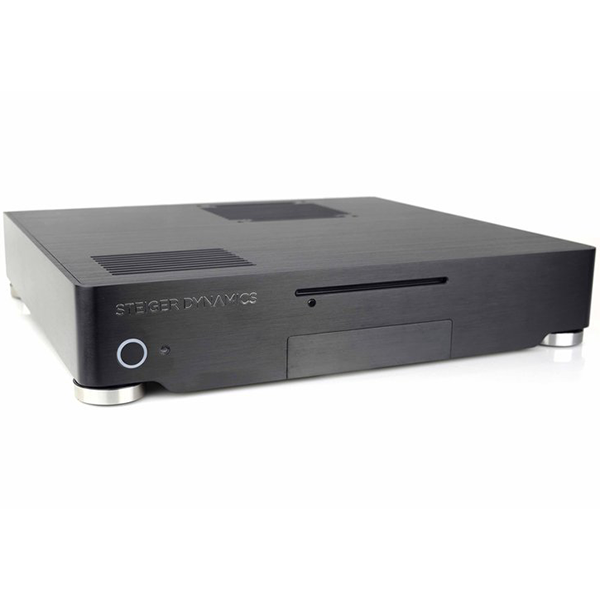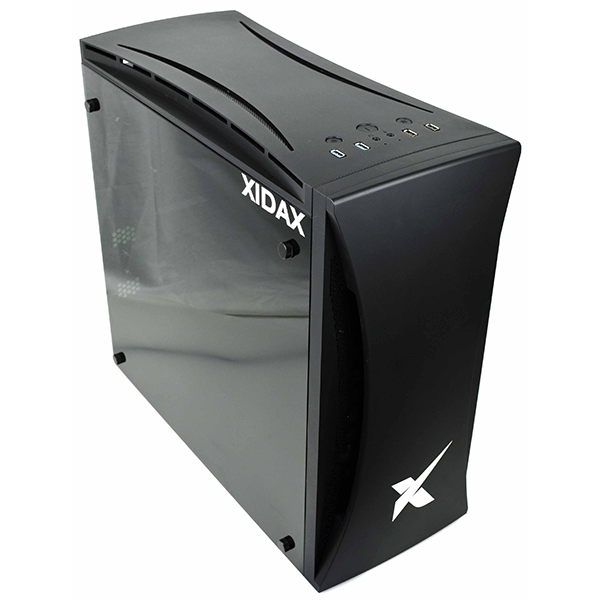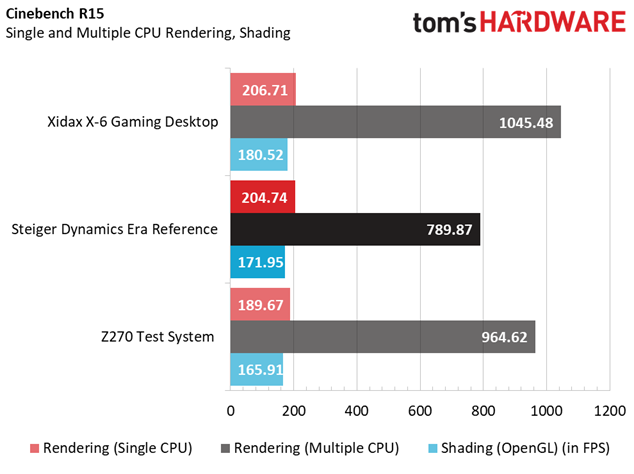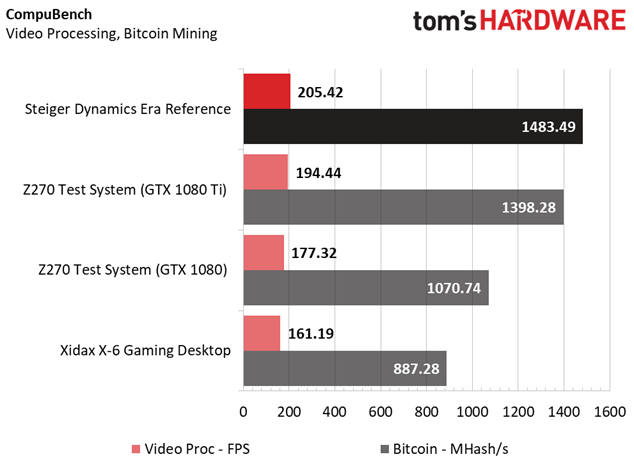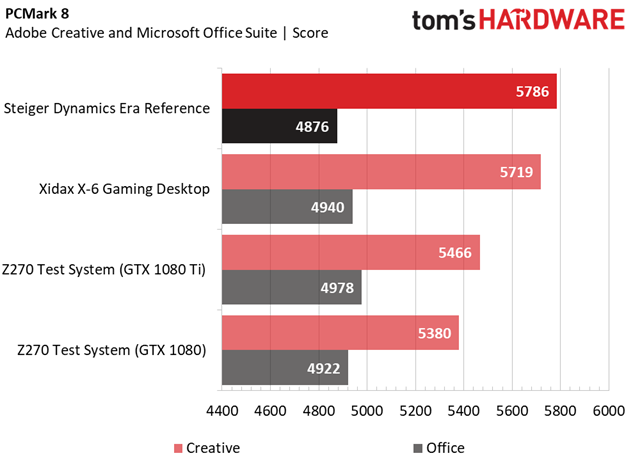Steiger Dynamics Era Reference Desktop Review
Why you can trust Tom's Hardware
Synthetic & Productivity Benchmarks
We recently built a new Z270 reference system for use in our desktop gaming PC reviews, with an Intel Core i7-7700K (clocked at its stock 4.2 GHz with a 4.5 GHz max turbo frequency in lightly threaded applications) in an ASRock Fatal1ty Z270 Gaming i7 ATX motherboard cooled by a Deepcool Gammaxx 400 heatsink and 120mm blue LED fan. We have a 16GB (2x8GB) kit of Kingston HyperX Savage DDR4-2133 memory running at the standard CAS latency of 15-15-15-36, and EVGA hooked us up with a set of the top-end Founder’s Edition graphics cards (a GTX 1080 Ti, 1080, and 1070) and a 1000W PSU to power it all. We use data from the GTX 1080 Ti and GTX 1080 for this review, and we run the GPUs at their respective default base and boost clock frequencies. You can check out the full specifications of our beastly test rig below.
Comparison Products
Test System Configuration
We also include data from our recent review of the Xidax X-6, which comes in about $800 cheaper but has a Core i7 processor and a GTX 1070 GPU under the hood. We don’t expect it to compete with Steiger’s GTX 1080 Ti and Core i5-7600K-powered platform in a framerate contest in our gaming benchmark suite, but it will give us a good indicator of when hyperthreading (the primary difference between a Core i5 and a Core i7 processor) is advantageous in CPU-intensive workloads, with both the Xidax and Steiger’s review samples sporting a CPU overclock of 4.8 GHz.
The Steiger Dynamics Era Reference features a Core i5-7600K overclocked to an all-core frequency of 4.8 GHz. Its 16GB (2x8GB) kit of DDR4-3000 features a CAS latency of 16-18-18-38, and it should provide above-average memory performance with its higher frequency. The EVGA GeForce GTX 1080 Ti Founder’s Edition’s core clock is boosted by 120 MHz using MSI Afterburner, and the company also pushed the memory clock up by 200 MHz. This gives the GPU inside the Era a boost clock of 1702 MHz and an effective memory data rate of 11.4 Gbps.
3DMark
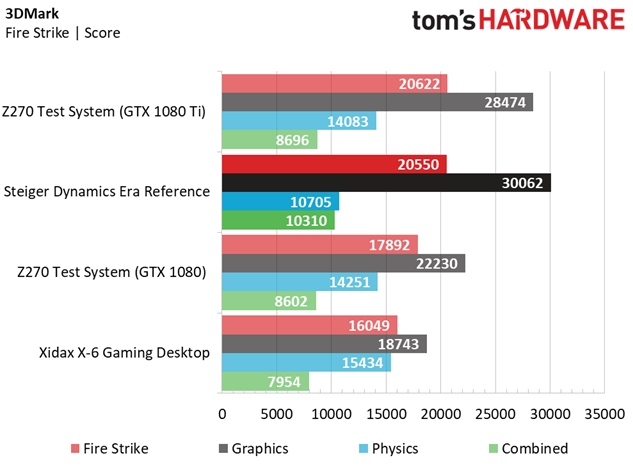
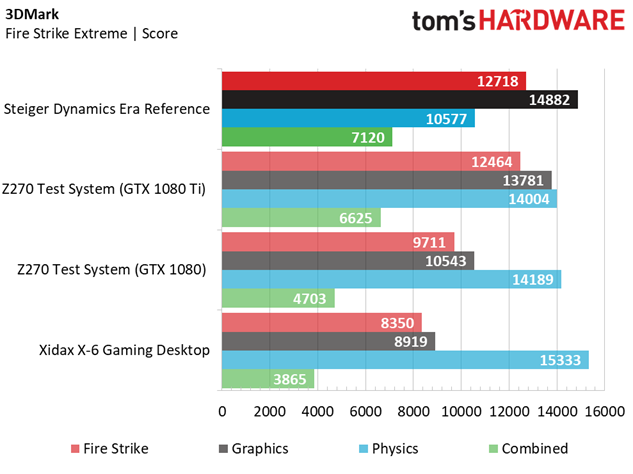
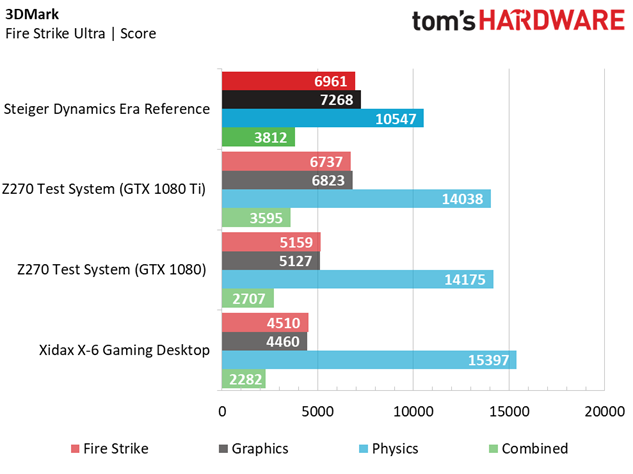
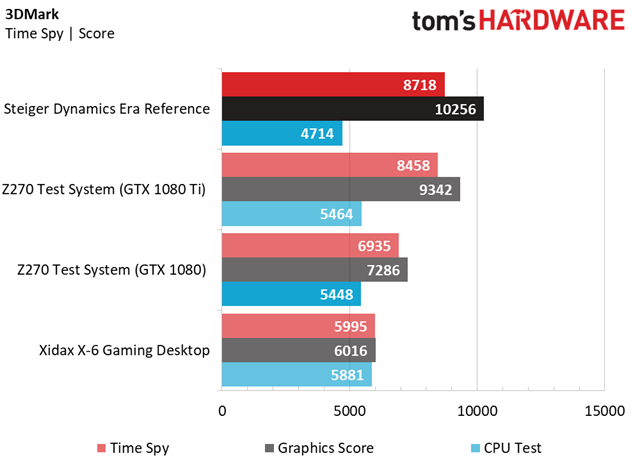
The Steiger Dynamics Era Reference starts our benchmark suite off with a moderate bang in the 3DMark Fire Strike tests. Despite its CPU and GPU overclock, the Era trails our stock-clocked Core i7-7700K/GTX 1080 Ti reference system thanks to a lower Physics score (CPU performance), which is to be expected. However, it still manages to net the highest Combined score in the 1080p synthetic workload by a substantial margin.
Fire Strike Extreme and Ultra place the Era at the top of the class, maintaining the highest Graphics and Combined scores throughout the tests but also trailing the pack in the Physics portion of the benchmark. Time Spy’s DX12 API repeats these findings, with the Era ahead in the overall Score and Graphics tests, but significantly behind in the CPU test.
Cinebench R15
Switching to a CPU-specific benchmark, we aren’t surprised to see the Core i7-7700K-equipped reference system and the Xidax X-6 completely blow away the Core-i5 Steiger offering in multi-threaded rendering performance. The X-6 also manages to edge out the Era Reference in single-threaded rendering and OpenGL shading workloads; its overclocked Core i7-7700K matches the Era’s Core i5-7600K core frequency, but it manages to push ahead by a small margin.
CompuBench
Compubench shows us that an overclock can go a long way on a GTX 1080 Ti, with the Steiger Dynamics Era Reference leading the field with the highest Video Processing and Bitcoin mining score. An overclock of 120 MHz nets about 85 MH/s compared to our reference rig with a stock-clocked Founder’s Edition, and we also see the Video Processing results improve by roughly 11 FPS.
Get Tom's Hardware's best news and in-depth reviews, straight to your inbox.
Storage Test
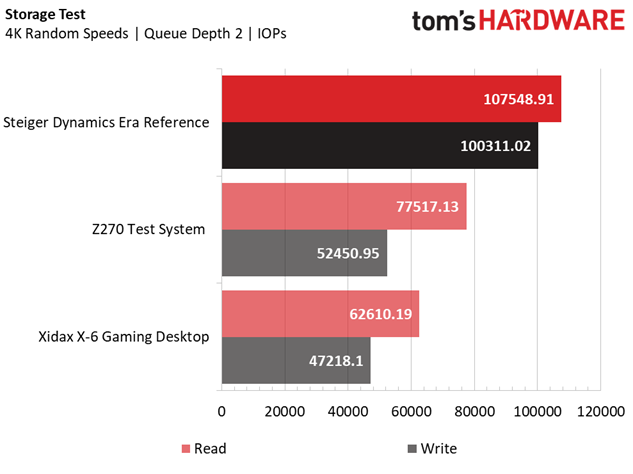
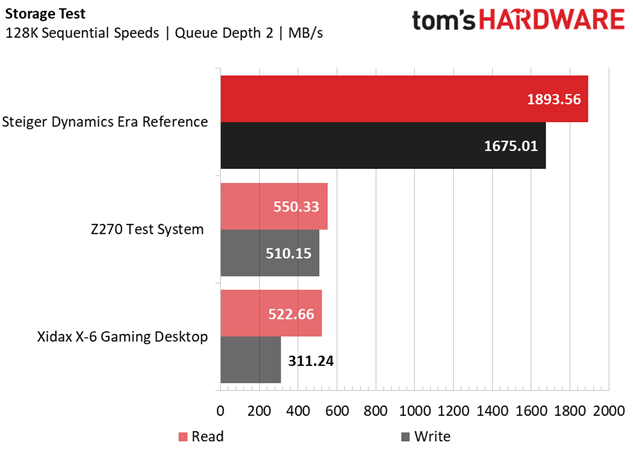
The Era’s 500GB Samsung 960 EVO M.2 NVMe SSD is fast, significantly faster than our reference system’s 960GB SATA SSD and the X-6’s 512GB SATA SSD. The 4K read and write IOPs reaches over 100K each, and the 128K sequential performance is downright impressive, with the Era achieving 1893.56 MB/s reads and 1675.01 MB/s writes. SATA storage devices just can’t compete against NVMe drives of this caliber; it’s like bringing a knife to a bazooka fight.
Sandra Memory Bandwidth
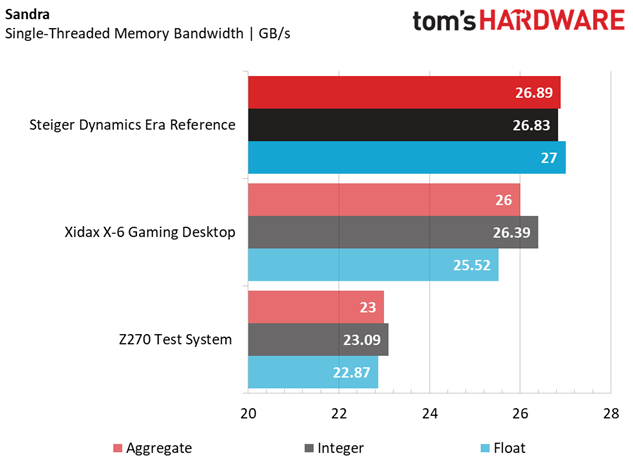
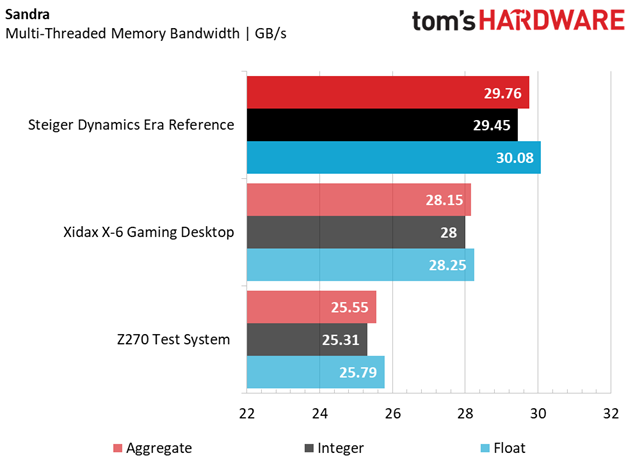
The Steiger Dynamics Era Reference once again predictably tops the chart with its higher memory frequency (3000 MHz), which provides a higher peak memory bandwidth over our test rig’s DDR4-2133 and the X-6’s DDR4-2666.
PCMark 8
With its higher memory frequency, overclocked CPU, and speedy storage, the Era Reference achieves an excellent score in the PCMark 8 Adobe application test. However, the Microsoft Office application tests are slightly less receptive to the Era’s Core i5-7600K, which falls behind the Core i7-equipped PCs in the lineup.
MORE: Best PC Builds
MORE: How To Build A PC
MORE: All PC Builds Content
Current page: Synthetic & Productivity Benchmarks
Prev Page Introduction & Product Tour Next Page Gaming BenchmarksDerek Forrest was a contributing freelance writer for Tom's Hardware. He covered hardware news and reviews, focusing on gaming desktops and laptops.
-
sargentchimera I'm generally one willing to pay extra for convenience, style, and interesting or even gimmicky features, but this is priced far too high. My system outperforms it on every level and is only worth around $1500, with nearly half of that being the 1080ti. I've bought from boutiques before I started building my own but this feels far higher than normal.Reply -
Rob1C It's 2x too expensive.Reply
Better off with something like the Asrock H110-STX MXM micro-STX Motherboard and a suitable case.
That can take an MXM Mobile PCIe Graphics Card (like Laptops use) and up to an i7. -
e-z e Always love seeing Steiger builds, if I had the resources that's the way I'd do it. Wish you guys had grabbed a few temperature measurements along the way. SFF and OC can be tricky on air.Reply -
the nerd 389 It certainly would have been nice if you'd measured the sound pressure/power level of the unit. It's supposed to be a key selling point of this model, and yet there's no attempt to test the claim that it's quiet.Reply
With other types of products that place an emphasis on acoustics, you tend to encounter a trend where the price of a product doubles for every 6-10 dB reduction in noise. (After a certain point, of course. The first 10-15 dB of reduction tends to be pretty cheap compared to the rest of a product.) That could have justified the otherwise ludicrous price they're asking for.
That strikes me as pretty unusual for a Tom's review. I expect more from you guys. -
Giroro What is with the ridiculous HDMI cable hanging out the back of the case? is that some kind of joke, or does their front HDMI panel seriously work that way?Reply -
Sarreq Teryx For all the style points on the exterior, I have to take away a ton of brownie point for that interior, and all those $49 each "extras" mentioned should be standard. It looks totally messy and unprofessional, and certainly not worthy of "Premium" or "Reference". You're paying for the brand name, rather than a good system.Reply
And I don't mean from an aesthetics standpoint, either. That GPU is half out of it's PCIe slot, and doesn't seem to be screwed in, from the pics. those cables could have easily have been customized, AT LEAST in length, if not going further by using smaller gauge silicone insulated cables, and maybe custom reduced size ATX connectors to better fit into the case (seeming the reason the GPU is crooked). They could have used a custom SFF or server PSU as well. This just looks lazy. -
Brian_R170 Not including the case, it looks like around $1500 in parts at prices an individual consumer would pay. Typical consumer-electronics retail prices are 2x the BOM cost, so a price of $3K might seem expensive, but it isn't really out of line.Reply -
islane That recessed, half-covered, crooked (!) GPU mounting is inexcusable at this price. I'm not the target audience for this, but I think even someone who isn't a DIY builder could look at this and see that something isn't right.Reply
